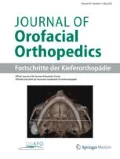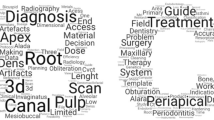Abstract
Introduction:
In order to obtain an overlay-free assessment of dental structures for resorption and ankylosis diagnostics, conebeam computed tomography (CBCT) is being employed more and more often in orthodontics alongside dental CT.
Objective:
The aim of this study was to investigate the quality and accuracy of CBCT in the imaging of dental structures and to compare it with the imaging quality produced by dental CT. Moreover, we intended to assess the specific advantages and disadvantages of CBCT in clinical use.
Materials and Methods:
The image quality of CBCT and dental CT was examined for a total of 417 teeth and their surrounding structures. 208 teeth were diagnostically recorded using volume tomography and 209 with dental CT. The axial images were assessed for metal and movement artifacts and whether there was an imprecise depiction of the enamel-dentin and pulp interface. The definition and reproductive quality of all teeth were evaluated when imaging the periodontal ligament space in the cervical, middle and apical root thirds.
Results:
In contrast to dental CT, metal artifacts were barely apparent in the CBCT and when so, only very feebly, whereas we only observed disruptions in image quality from movement artifacts with CBCT. Image quality of the dental and surrounding bony structures was far better with dental CT on the whole than it was with CBCT. During imaging by CBCT, the periodontal ligament space either could not be, or if so, then only poorly assessed for 86% of the teeth, while this figure was only 20% for dental CT. Furthermore, the enamel-dentin interface and pulp cavity’s edges were on the whole much more sharply defined in the dental CT.
Conclusion:
Dental CT still represents the gold-standard for inspecting the dental roots and their surrounding bone.
Zusammenfassung
Hintergrund:
Zur überlagerungsfreien Beurteilung dentaler Strukturen im Rahmen der Resorptions- und Ankylosediagnostik wird in der Kieferorthopädie neben dem Dental-CT zunehmend die Digitale Volumentomographie (DVT) eingesetzt.
Ziel:
Ziel dieser Studie war es, die Qualität und Genauigkeit der DVT bei der Darstellung dentaler Strukturen zu untersuchen und mit der Abbildungsqualität im Dental-CT zu vergleichen. Daneben sollten die spezifischen Vor- und Nachteile der DVT im klinischen Einsatz analysiert werden.
Material und Methoden:
In der vorliegenden Studie wurde die Abbildungsqualität von DVT und Dental-CT an insgesamt 417 Zähnen und ihren umgebenden Strukturen untersucht. Datensätze von 208 Zähnen wurden mit der DVT und von 209 Zähnen mit der Dental-CT akquiriert. Die axialen Bilder wurden auf Metall-, Bewegungsartefakte und eine unscharfe Darstellung von Schmelz-Dentin- und Pulpa-Grenze hin beurteilt. Auch die Schärfe und Abbildungsgenauigkeit der Darstellung des Parodontalspaltes im zervikalen, medialen und apikalen Wurzeldrittel wurde bei allen Zähnen bewertet.
Ergebnisse:
Metallartefakte traten bei der DVT im Gegensatz zum Dental-CT kaum und nur sehr abgeschwächt auf, während Störungen der Bildqualität durch Bewegungsartefakte ausschließlich bei der DVT zu sehen waren. Die Darstellungsqualität der dentalen und umgebenden, knöchernen Strukturen war beim Dental-CT im Durchschnitt deutlich besser als bei der DVT. Während bei Aufnahmen der DVT der Parodontalspalt bei 86% der Zähne nicht oder nur sehr schlecht zu beurteilen war, lag diese Quote bei den Dental-CTAufnahmen bei 20%. Auch die Schmelz-Dentin-Grenze und die Ränder des Pulpenkavums wurden im Dental-CT im Durchschnitt deutlich schärfer dargestellt.
Schlussfolgerung:
Bei der Beurteilung feiner Strukturen im Bereich der Zahnwurzeln und ihres umgebenden Knochens zeigt sich das Dental-CT der DVT qualitativ überlegen und stellt somit weiterhin den Goldstandard dar.
Similar content being viewed by others
Author information
Authors and Affiliations
Corresponding author
Rights and permissions
About this article
Cite this article
Holberg, C., Steinhäuser, S., Geis, P. et al. Cone-Beam Computed Tomography in Orthodontics: Benefits and Limitations. J Orofac Orthop 66, 434–444 (2005). https://doi.org/10.1007/s00056-005-0519-z
Received:
Accepted:
Issue Date:
DOI: https://doi.org/10.1007/s00056-005-0519-z



